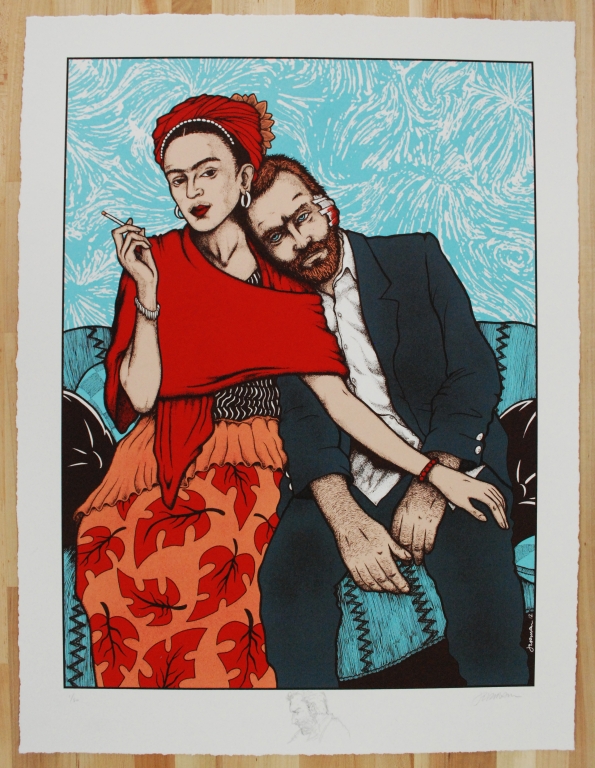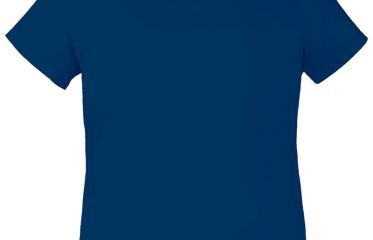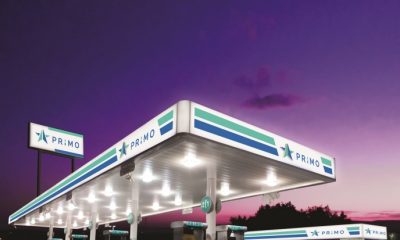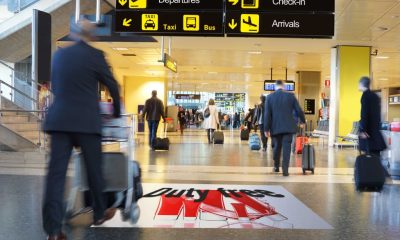Graphics Printing
Published
11 years agoon

Graphics play a critical role in our daily lives. In fact, they’re such an integral part of so many things that people often take them—and the many pains involved in their production—for granted. The following showcase sets its sights on a range of printed graphics, from pieces of fine art to retail displays, and gives some attention to the shops behind them.
Graphics play a critical role in our daily lives. In fact, they’re such an integral part of so many things that people often take them—and the many pains involved in their production—for granted. The following showcase sets its sights on a range of printed graphics, from pieces of fine art to retail displays, and gives some attention to the shops behind them.
Coronado Studio / Austin, TX
www.coronadostudio.com
Coronado Studio was founded in 1992. It occupies two buildings, employs three to five people, has a couple of contractors, and runs an internship program in printing, design, and grant writing. Coronado’s non-profit, Serie Project (www.serieproject.org), started the following year and was formally incorporated in 1999.
Serie Project is a founding member of the Consejo Grafico, the consortium of Latino printmakers. Its purpose is to give a greater voice to artists through the medium of serigraphy and to provide affordable art for the public. All Serie Project prints are produced in a run of 50 that are then divided between the artist and the studio. Approximately 70 pieces total are printed to ensure a full run.
The shop’s equipment includes a clamshell press, metal screen frames, and a vacuum table. The studio usually works with mesh counts in the range of 280-305 threads/in. According to Brian Rise, master printer at Coronado Studio, separations are typically created by the artists by hand on Mylar sheets using any opaque material. When computer-generated separations are used, they’re printed to vellum or film by an outside shop. Coronado’s exposure unit and washout tank are handmade.
The studio uses TW inks and Ulano emulsion, and prints are made on 100% cotton rag, acid-free, heavyweight paper from various sources. An embossed chop with the Coronado logo is applied to every print by hand.
“The artists are present in residency while the print is being created,” Rise explains. “We try to tell artists to stay around the range of ten colors so that we can finish in the time allotted, but there is no real deadline to speak of. Each Serie Project print is a work of art, so each has the potential to be unique and impressive. The end result of all our work is the creation of fine-art prints for public purchase.”
Lady Lazarus / Houston, TX
www.ladylazaruspress.com
Lady Lazarus was founded in 2012. The three-person shop uses 2750 sq ft of space to produce screen-printed art editions and gig posters. Based on founder Isaac Menge’s description of the print shown here, Lady Lazarus isn’t afraid to take on challenging work.
“A few of the screens included large-coverage inked areas alongside 600-dpi dithered halftones. Squeegee pressure and angle played a large role in achieving good ink coverage while maintaining a crisp and clean print quality across the various textures each individual stock had to offer,” Menge explains. “A good amount of attention was spent on color proofing and color registration while on press. The hand deckling, although time consuming, added a very nice touch to the art-print edition.”
Frida y Vincente was printed on a Cincinnati press with a one-arm squeegee with water-based ink and six Pantone spot colors. The shop used films output on an Epson 9600, Kiwo Poly Plus-S emulsion, and an exposure unit from TMI for stencilmaking. Substrates involved in the project included Coventry Rag Cotton fine-art paper, French Paper colored cover stock, Cougar cover stock, and NovaVision holographic foil. Finishing work included trimming on a Wohlenberg MCS-3 TV. Turnaround time for this internationally distributed work was one week.
LastLeaf Custom Print & Design / Pueblo, CO
www.lastleafprinting.com
Mathias Valdez and his assistant run LastLeaf Custom Print & Design in an 1800-sq-ft space and have been in business since 2009. “The only two uses for my works are as gig/tour posters commissioned by bands for sale as merchandise or art prints that are usually made for gallery shows across the country—or sometimes just for fun. All of them end up for sale as wall art,” Valdez says.
The work shown here was printed in three colors in an edition of 90 as a tour poster for a Brooklyn, NY-based called O’Death. The design was a combination of hand illustration and collage. The print was made by overlaying colors and using negative space to make the final image. A metallic-silver ink created the highlights in the cabin and moon.
Valdez uses an SPE semiautomatic screen press for larger quantities and prints smaller editions by hand. Posters are made with 100-lb cover stock, usually from Lynx or Cougar, and acrylic inks—most often Speedball. According to Valdez, each poster job is finished in a day or two, not including design time, which can vary greatly.
The Little Friends of Printmaking / Milwaukee, WI
www.thelittlefriendsofprintmaking.com
Melissa and James Buchanan have worked as The Little Friends of Printmaking since 2003. As Melissa puts it, “We’re just two illustrators/artists with a home studio; we employ no one but ourselves, and we print by hand on a $75 Uline utility table.”
Their printshop may sound low-tech to some, but the Buchanans have earned recognition for their work and have racked up some heavy commissions, such as the work shown here. This job came from the Renwick Gallery of the Smithsonian American Art Museum for its “40 Under 40: Craft Futures” exhibition. Melissa says the project was unusual for the Smithsonian American Art Museum, because the institution doesn’t typically commission outside artists to create exhibition posters.
“Doing so allowed them to use handcraft to promote a show about handcraft; to make the poster an element of the exhibition in a way that it wouldn’t ordinarily be. For our part, we were able to represent artists and artwork from the exhibition in our poster, so that it didn’t just function as a poster or a promotional item, but as a mini-catalogue,” she explains.
The Little Friends of Printmaking produced the three-color design in an edition of 400 pieces on French Paper’s Pop-Tone Blue Raspberry. Melissa says the entire design process, from approved sketches to prepress, took about 40 hours and that she and James spent three full days printing.
“The poster was designed and prepared for print on a desktop computer using Flash MX and Adobe Illustrator CS. Film separations were produced at a local architectural-printing depot from an Océ plotter. The printing was done on a Uline utility table with Speedball hinge clamps attached by large carriage bolts, alongside a Saturn drying rack,” she says.
Midnight Oil Creative/LAgraphico / Burbank, CA
www.midnightoilcreative.com / www.lagraphico.com
Midnight Oil Creative/LAgraphico recently partnered once again with Universal Pictures for a theatrical marketing campaign—this time for Les Miserables, the critically acclaimed film version of the Broadway and global live productions. The outdoor component of the campaign included bus kings, billboards, bus benches, bus shelters, subway two-sheets, mall kiosks, airport dioramas, backlit spectaculars, premiere panels, building wraps, and specialty boards for the Universal Studios lot.
“Regardless of the final form and substrate, the integrity of the brand, of color, the softness of hair, color of eyes, and title treatments remain consistent,” says Michael Griffin, marketing and P.R. for Midnight Oil Creative/LAgraphico. “A common picture is painted, whether you’re driving in your car, in the theatre, traveling on the bus or subway or airplane, or shopping in your local mall.”
The outdoor graphic shown here is a 63-ft-wide x 40-ft-tall building installation at the intersection of Franklin and Highland Avenues in Hollywood. According to Griffin, the spot is seen by millions of people and is located near the Hollywood Bowl, a block from Hollywood Boulevard, and close to other famous landmarks. The side of the building was prepped with underpinning to accept adhesive wraps.
The graphics were printed on a Durst Rho UV inkjet printer and installed in long, narrow pieces. The substrate’s permanent adhesive is formulated for long-term use in outdoor applications. Finishing involved manually trimming and labeling each panel. “Somewhat like a puzzle, the pieces are labeled numerically so installers know where to place each piece,” Griffin explains.
Modernistic / Stillwater, MN
www.modprint.com
Modernistic was founded in 1938. The company operates in a 130,000-sq-ft facility and has a staff of 150. The graphics-printing and fabricating specialist recently took on a retail-display project, from prototyping through assembly, that involved multiple substrates, print runs on an M&R Insignia press, and finishing processes involving Zund and Gerber routers.
Modernistic worked from a rough concept and eventually selected ABS, PETG, and edge-lit acrylic for the display’s construction—the latter of which enabled Modernistic to eliminate the powered lighting initially considered for the project. Modernistic co-CEO Scott Schulte explains that a white base and a fluorescent green were screen printed onto the ABS base for the brand markings and that a protective clearcoat was then laid down on top of everything.
“From there, we routed flat sheets into component parts and heat-bent and solvent-welded them, capping the top. There’s also some surface routing once the cap is on,” he explains.
The leading edge of the slide-out tray in front was also screen printed with a white base and fluorescent green on top. The slots on the right and left are literature holders, inside of which are pockets Modernistic fabricated. Other components include bump-ons on the bottom and back of the display, hardware that allows the display to be used on countertops or pegboards, and more.
The job run involved the manufacture of 2,000 displays and a four-week turnaround time. Modernistic also provided partial assembly for the nationally distributed display and supplied a kit for the hardware, a move that Schulte says saved a considerable amount of space for shipping.
PSP / Decatur, GA
www.simply-reliable.com
PSP was founded in 2002. The 35,000-sq-ft operation has a staff of 37 and specializes in turnkey production of graphic displays. A national client approached PSP during the recent holiday season to create a promotional piece that would attract foot traffic—not the easiest task in the midst of shopping frenzies and with very short turnaround.
Working with a custom substrate presented yet another challenge. According to Voula Giannakopoulos, production manager at PSP, the stock was a metallic, gold- and silver-foil-laminated, 24-pt board from Crusader Paper.
“The lead time was two to three weeks, and the stock presented the potential danger of bounce-back from the UV light, which could cause the inks to dry on the printheads instead of drying properly on the stock,” Giannakopoulos says. “We were able to eliminate both concerns by using two different pieces of large-format, high-speed digital printing equipment.”
PSP put the project on its Scitex HP FB7600 and Scitex HP TJ8600. Giannakopoulos explains that the print speeds of the FB7600 and TJ8600—70 boards/hr and 60 drums/hr, respectively—and the positioning of the systems’ printheads and curing units allowed the shop to meet its production deadline and avoid the ink-curing problems that could have been created by the media’s metallic elements. Giannakopoulos also notes that proprietary software allows PSP to create labels for distribution, customized to each store, as display graphics are packed for shipment.

Subscribe

Magazine
Get the most important news
and business ideas from Screenprinting Magazine.
Most Popular
-

 Case Studies2 months ago
Case Studies2 months agoHigh-Density Inks Help Specialty Printing Take Center Stage
-

 Art, Ad, or Alchemy2 months ago
Art, Ad, or Alchemy2 months agoF&I Printing Is Everywhere!
-

 Andy MacDougall2 months ago
Andy MacDougall2 months agoFunctional and Industrial Printing is EVERYWHERE!
-

 Columns3 weeks ago
Columns3 weeks ago8 Marketing Mistakes Not to Make When Promoting Your Screen Printing Services Online
-

 Editor's Note3 weeks ago
Editor's Note3 weeks agoLivin’ the High Life
-

 Marshall Atkinson3 weeks ago
Marshall Atkinson3 weeks agoHow to Create a Winning Culture in Your Screen-Printing Business
-

 Thomas Trimingham2 months ago
Thomas Trimingham2 months ago“Magic” Marketing for Screen Printing Shops
-

 News & Trends2 months ago
News & Trends2 months agoWhat Are ZALPHAS and How Can You Serve Them in Your Print Business?






